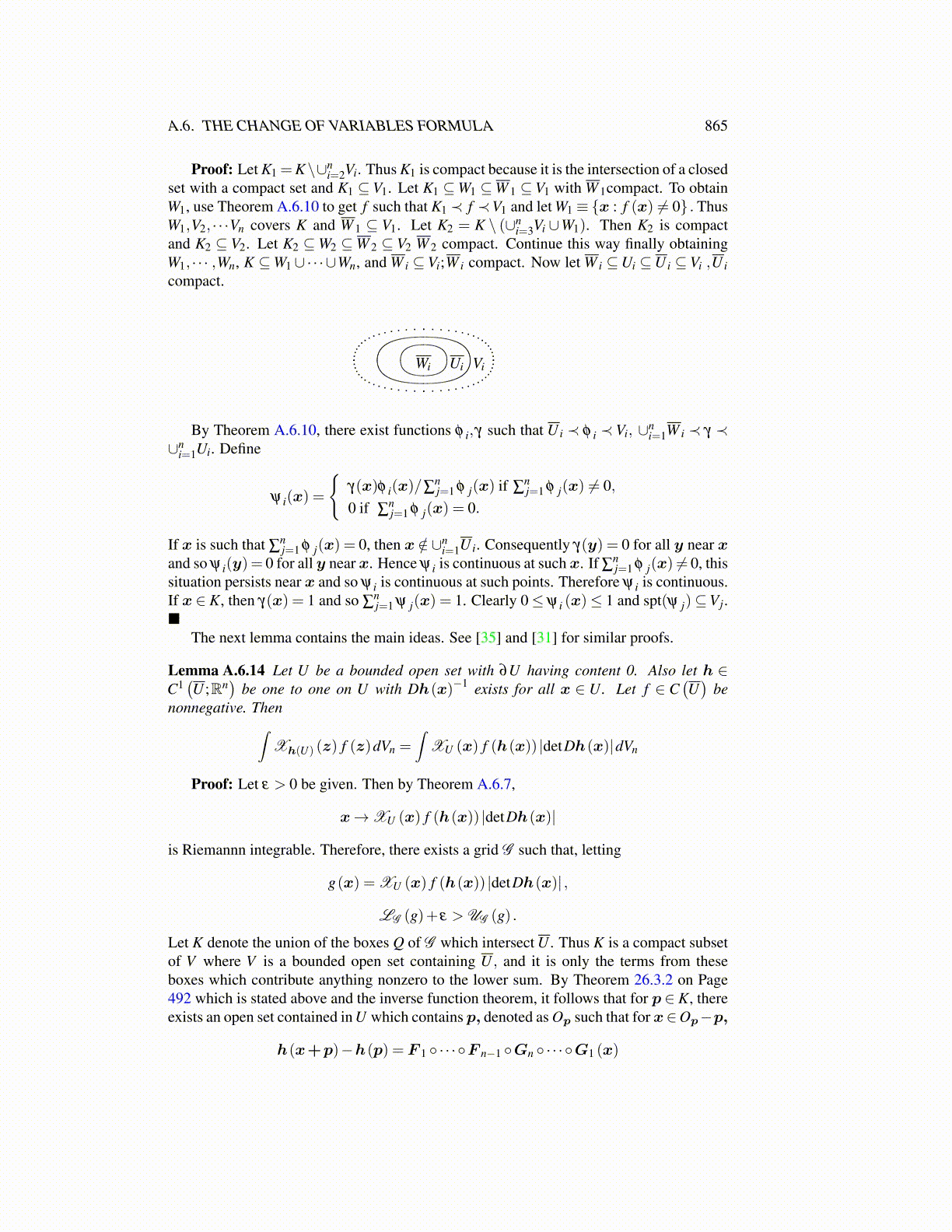
A.6. THE CHANGE OF VARIABLES FORMULA 865
Proof: Let K1 =K\∪ni=2Vi. Thus K1 is compact because it is the intersection of a closed
set with a compact set and K1 ⊆ V1. Let K1 ⊆W1 ⊆W 1 ⊆ V1 with W 1compact. To obtainW1, use Theorem A.6.10 to get f such that K1 ≺ f ≺V1 and let W1 ≡ {x : f (x) ̸= 0} . ThusW1,V2, · · ·Vn covers K and W 1 ⊆ V1. Let K2 = K \ (∪n
i=3Vi ∪W1). Then K2 is compactand K2 ⊆ V2. Let K2 ⊆W2 ⊆W 2 ⊆ V2 W 2 compact. Continue this way finally obtainingW1, · · · ,Wn, K ⊆W1∪ ·· ·∪Wn, and W i ⊆ Vi;W i compact. Now let W i ⊆Ui ⊆U i ⊆ Vi ,U icompact.
Wi Ui Vi
By Theorem A.6.10, there exist functions φ i,γ such that U i ≺ φ i ≺ Vi, ∪ni=1W i ≺ γ ≺
∪ni=1Ui. Define
ψ i(x) =
{γ(x)φ i(x)/∑
nj=1 φ j(x) if ∑
nj=1 φ j(x) ̸= 0,
0 if ∑nj=1 φ j(x) = 0.
If x is such that ∑nj=1 φ j(x) = 0, then x /∈ ∪n
i=1U i. Consequently γ(y) = 0 for all y near xand so ψ i(y) = 0 for all y near x. Hence ψ i is continuous at such x. If ∑
nj=1 φ j(x) ̸= 0, this
situation persists near x and so ψ i is continuous at such points. Therefore ψ i is continuous.If x ∈ K, then γ(x) = 1 and so ∑
nj=1 ψ j(x) = 1. Clearly 0≤ ψ i (x)≤ 1 and spt(ψ j)⊆Vj.
■The next lemma contains the main ideas. See [35] and [31] for similar proofs.
Lemma A.6.14 Let U be a bounded open set with ∂U having content 0. Also let h ∈C1(U ;Rn
)be one to one on U with Dh(x)−1 exists for all x ∈ U. Let f ∈ C
(U)
benonnegative. Then∫
Xh(U) (z) f (z)dVn =∫
XU (x) f (h(x)) |detDh(x)|dVn
Proof: Let ε > 0 be given. Then by Theorem A.6.7,
x→XU (x) f (h(x)) |detDh(x)|
is Riemannn integrable. Therefore, there exists a grid G such that, letting
g(x) = XU (x) f (h(x)) |detDh(x)| ,
LG (g)+ ε > UG (g) .
Let K denote the union of the boxes Q of G which intersect U . Thus K is a compact subsetof V where V is a bounded open set containing U , and it is only the terms from theseboxes which contribute anything nonzero to the lower sum. By Theorem 26.3.2 on Page492 which is stated above and the inverse function theorem, it follows that for p ∈ K, thereexists an open set contained in U which contains p, denoted as Op such that for x∈Op−p,
h(x+p)−h(p) = F 1 ◦ · · · ◦F n−1 ◦Gn ◦ · · · ◦G1 (x)